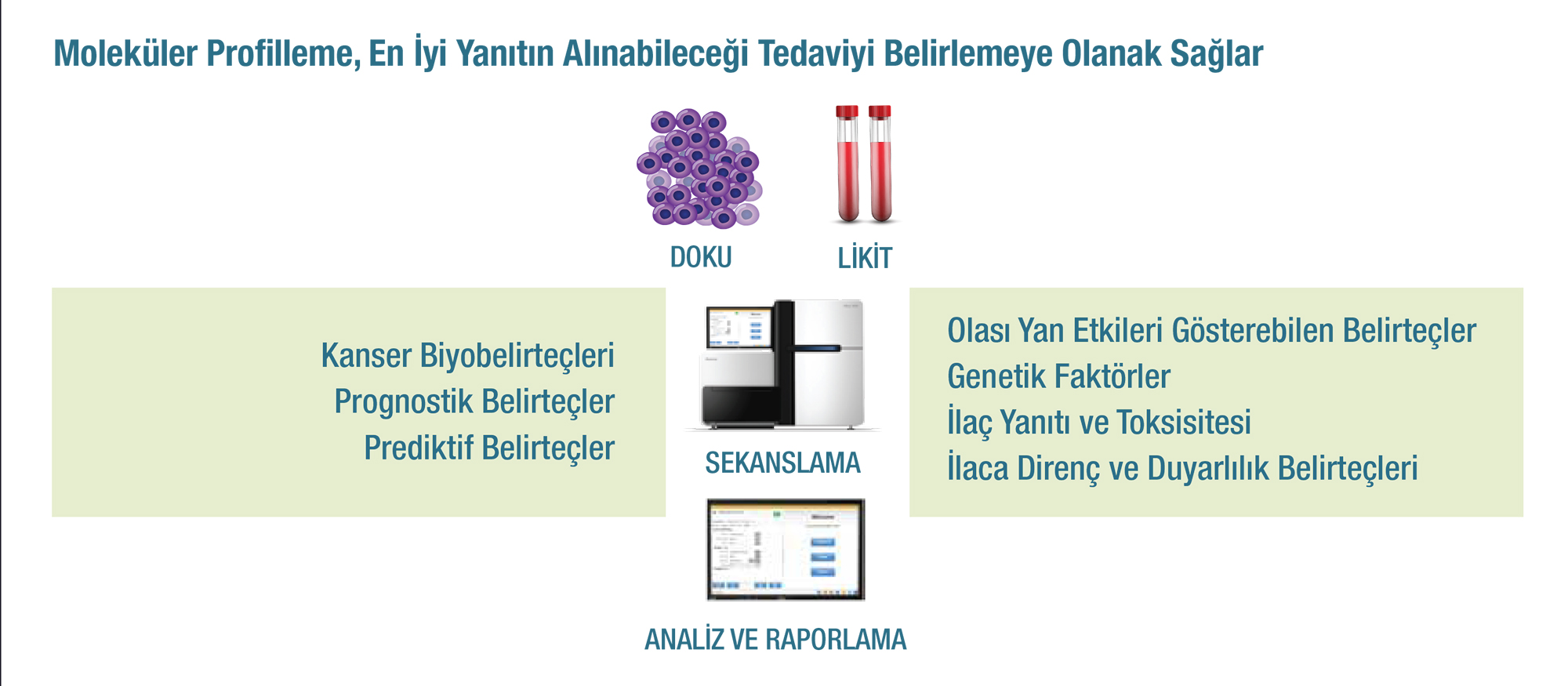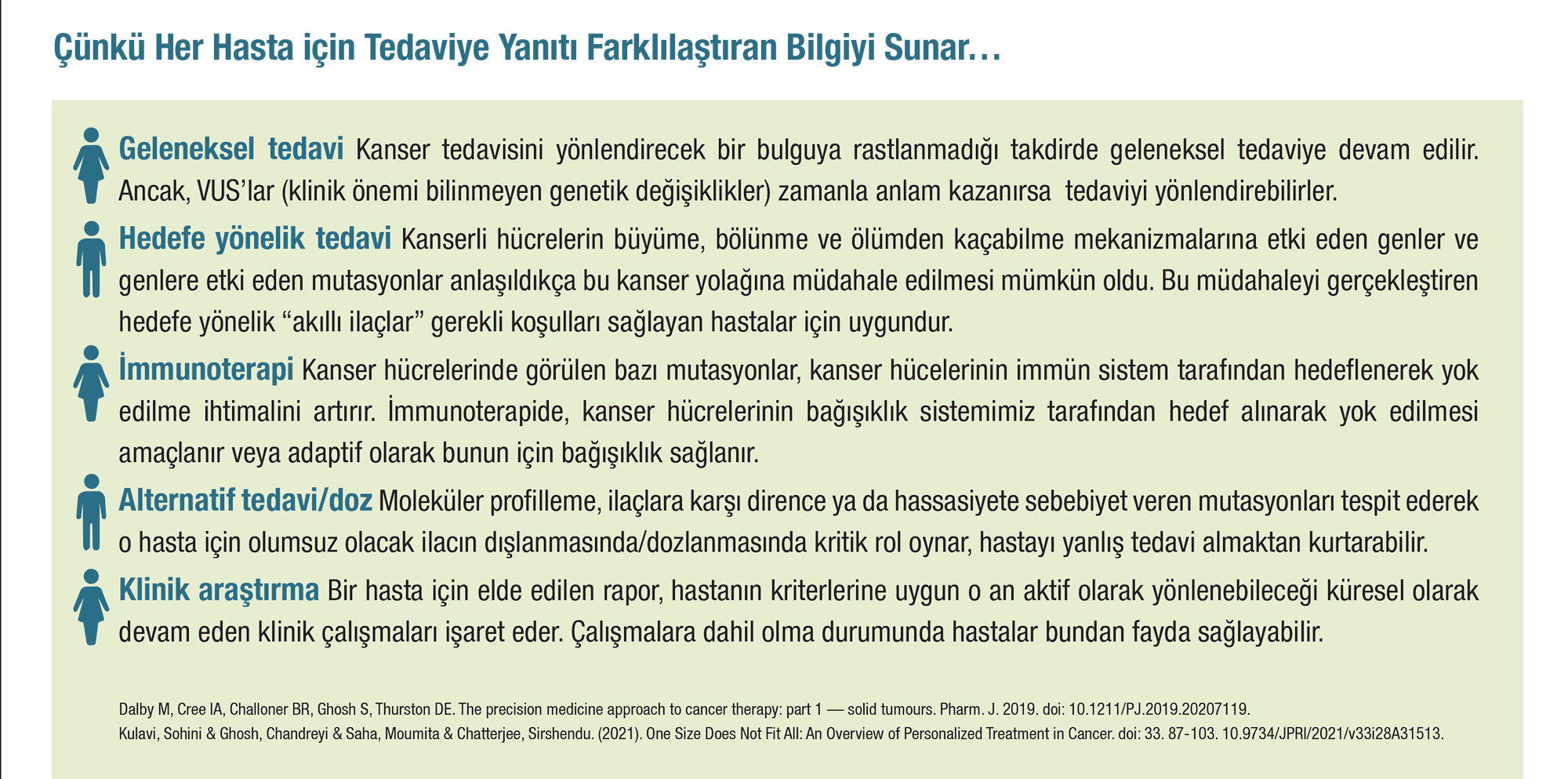Cancer is a living cell
with intelligence. We should keep in mind that we are litigating with such an enemy.
Tumor profiling is the most important step towards personalized and truly targeted treatment.

Why is it “personalized”?
In a healthy body, cells are born, grow and die just like people. Cells divide to form new cells, which carry out their tasks and then die when the time comes. However, one or more damages on DNA disrupt this cycle in cells; the cell can escape death by prolonging the time it takes to die, grow and divide uncontrollably, and thus become cancerous and form tumor tissue. This growth or division does not progress in the same way in every patient.Although cancer has certain patterns, it is a personalized disease. Therefore, it should be evaluated and treated individually.
The cause of cancer is not known for certain, but various environmental and hereditary factors are known to play a role. Age, gender and family disease history are examples of hereditary factors. Smoking and alcohol use, eating habits and stress are just a few of the environmental factors. The reason why cancer differs from person to person is that each patient is affected by these factors differently and at different proportions.
Early diagnosis is extremely important and critical in analyzing the disease and deciding on the right treatment method, taking into account the risk factors of the person.
Each type of cancer has different characteristics. Some types of cancer spread faster, while others spread more slowly. The different progression of cancer in each individual also requires each individual to receive individual and personalized treatment.
In order to give you the most effective treatment, you need to find the right option, and your treatment needs to be tailored to the characteristics of your cancer. Genomic information from tumor profiling tests therefore plays an important role in personalized medicine.
Genetic tests examine the genetic structure of cancer using advanced technology. It precisely identifies biomarkers that play a role, if any, in the progression and development of cancer, drug response and toxicity, and information that differentiates response to treatment such as drug resistance and sensitivity, and helps personalize your treatment plan by determining treatment options in line with this data.
Tumor profiling is a genetic analysis that can be performed from the patient’s tumor tissue or blood, which allows us to obtain detailed information about the cause and prognosis of cancer. Thanks to these analyses, all changes (mutations) of the tumor can be detected. This determines the specific pathway to be followed for each patient. For example, when two lung cancer patients undergo a tumor profiling test, one may have a mutation and be treated with a smart drug, while the other patient may not have a drug-directed mutation and may need to start standard cancer treatment (chemotherapy, radiotherapy, immunotherapy).
Next Generation Sequencing (NGS) is used in tumor profiling tests. The NGS method allows the patient’s DNA molecule to be read thousands of times to detect even minor changes.
As Nesiller, our NGS Focus© tests that we work with molecular profiling method are as follows;
- NGS Focus 77 Liquid
- NGS Focus 77 Tissue
- NGS Focus 500
- NGS Focus 500 HRD
- NGS Focus CGP
- NGS Focus HEREDITER (Hereditary)
Hereditary cancer tests determine a person’s risk of developing cancer, allowing the disease to be diagnosed at a very early stage. This will help predict the course of the disease and determine the best plan for treatment.
Hereditary cancer is caused by mutated (altered) genes passed on from parents to children. These types of cancer are transferred from one generation to another that is called genetic inheritance and have a much higher incidence at an early age. For this reason, “Hereditary Cancer Tests” are recommended for individuals with a family history of cancer.
The NGS Focus© HEREDITER Test studied in our laboratory is recommended. The test screens for 113 genes that may be associated with many types of cancer, mainly breast, ovarian, colon and stomach cancers.
A. Surgical Treatment
Surgery is the first line of treatment for many types of cancer. This method prevents the spread of cancer tissue throughout the body and increases the effectiveness of the treatment.
B. Chemotherapy
The aim of chemotherapy is to prevent or slow down the growth, proliferation and spread of the disease, depending on the type and stage of the cancer.
Chemotherapy drugs are divided into classes. Some drugs act directly on the tumor, while others are hormonal or immune boosting drugs. Factors such as the stage of the disease, age or disease history of the person are taken into account when choosing the type of medication.
For some types of cancer, chemotherapy is the only viable treatment. Sometimes it can be used to support treatment methods such as surgery or radiotherapy. Chemotherapy can be administered orally, intravenously or into body cavities.
C. Radiotherapy
Radiotherapy is a method of treating cancer with radiation. The aim here is to disrupt the structure of cancer cells with radiation and prevent them from multiplying. Radiotherapy can be used alone or in combination with chemotherapy and/or surgery in cancer treatment. For example, it is also used pre-operatively to make the piece suitable for surgery. In some inoperable areas (such as nasopharyngeal cancer), radiotherapy alone is an effective treatment.
Although cancer is one of the diseases with the highest incidence rate, the success rate is increasing significantly thanks to new generation treatment methods. Targeted therapy and immunotherapy are the most successful methods in this field.
A. Targeted Therapy – Smart Drugs
Smart drug use is one of the most important tools of targeted therapy. Smart drugs specific to specific mutations detected in various types of cancer have been developed. Smart drugs recognize the growth mechanisms of cancer cells at the molecular level and aim to block the signals that trigger these mechanisms.
B. Immunotherapy
When the immune system encounters cancer cells, it fights and tries to destroy them. However, in some cases, cancer cells can evade the immune system by disrupting the immune system’s recognition mechanism and continue to proliferate. There are many studies on the immune system against such treatment inhibitors.
The aim of immunotherapy treatment is to strengthen and activate the patient’s immune system, enabling to better act against cancer. It is recommended for patients with advanced cancer. Immunotherapy is currently used as a supportive treatment.
C. “Personalized treatment” with tumor profiling
In recent years, the personalization of cancer, that is, the study of its molecular structure on an individual basis, has completely changed the general understanding of cancer treatment.
Targeted therapy greatly reduces the toxicity and other side effects associated with conventional treatments such as chemotherapy, leading to an increase in patient survival and quality of life. In addition, resistance mutations that can be detected through tests can also be kept under control during the treatment process. In this way, the success rate in the treatment process is increased. For all these reasons, tumor profiling at the molecular level has added a new dimension to the understanding of cancer treatment.
Tumor profiling tests detect cancer-specific mutations in the patient so that personalized treatment can be administered.
In our bodies, cells that enter the death pathway are broken down and the material in them circulates in our blood until it is broken down by the liver and filtered by the kidneys. This material can be from healthy cells that have outlived their natural lifespan, or from tumor cells that have been destroyed by our immune system and various treatments. Circulating free DNA (cfDNA) is an example of such material.
Liquid biopsy is a method used to detect and analyze circulating tumor cells in the body or DNA and RNA released from tumor cells.
These genetic materials are screened for mutations that may affect the diagnosis and treatment of cancer, and thus provide more detailed information about the disease.
In addition to diagnosis, the liquid biopsy method has an extremely important place in terms of treatment planning and follow-up. For example, in the event of a decrease in the effect or ineffectiveness in a successful treatment process in a cancer patient, it will be considered that the patient may have a resistance mutation. To determine this, instead of biopsy, the patient can be directed to a liquid biopsy and only a blood sample will be sufficient to come to a conclusion and a new treatment plan can be created.
The biggest advantage of liquid biopsy compared to methods using tissue is if the tissue is not sufficient for analysis, the biopsy should be repeated, while the liquid biopsy method eliminates this. Similarly, in tumors that develop in places where biopsy is not possible or where health conditions are not suitable for biopsy, liquid biopsy provides to patient an opportunity for genetic study.

Molecular Profiling for Personalized Cancer Therapy
The Most Important Step

HRD detection in comprehensive genomic profiling
Cancer type All Solid Tumors and Sarcoma
Sample type Tissue
Method NGS (Next Generation Sequencing)
Genomic signature 523 genes DNA + 55 genes RNA / (SNP, CNV, InDel, Fusion) + MSI + TMB + HRD
Approximate delivery 2-3 weeks
Advantages
The use of RNA for fusion detection allows rare fusions to be detected, while a comprehensive analysis of DNA provides a highly detailed screening and increases the accuracy of the TMB score.
HRD is recognized as a defect of the DNA repair mechanism. 500 HRD investigates the presence of HRD by GIS score calculation using an FDA-approved algorithm and predicts benefit from PARP inhibitors*.
*The presence of HRD in a cancer correlates with its response to PARP inhibitor therapy. This is particularly reported in ovarian, prostate, pancreatic and triple negative breast cancers and contributes to the determination of treatment options.

500+ gene analyses covering key guidelines and clinical studies
Cancer type All Solid Tumors and Sarcoma
Sample type Tissue
Method NGS (Next Generation Sequencing)
Genomic signature 523 genes DNA + 55 genes RNA / (SNP, CNV, InDel, Fusion) + MSI + TMB
Approximate delivery 2-3 weeks
Advantages
The use of RNA for fusion detection allows rare fusions to be detected, while a comprehensive analysis of DNA provides a highly detailed screening and increases the accuracy of the TMB score.
It also determines the status of TMD and MSI as a result of comprehensive analysis and contributes to finding the most appropriate treatment for the individual.

Examines 4 major classes of mutations in 60 genes involved in clinical trials, with 17 genes recommended by NCCN and other guidelines
Cancer type All solid tumors, especially lung and colorectal cancers
Sample type Tissue
Method NGS (Next Generation Sequencing)
Genomic signature 77 gene DNA (SNP, CNV, InDel, Fusion)
Approximate delivery 2-3 weeks
Advantages
This test detects 4 main types of alterations in tumor DNA and provides highly accurate results with hybrid capture technology.
Analyzes DNA variants in 77 genes included in the NCCN guidelines and important biomarkers included in clinical studies.

An important option for cancer diagnosis and monitoring: Liquid Test
Cancer type All solid tumors, especially lung and colorectal cancers
Sample type Liquid (ctDNA) – two tubes of blood
Method NGS (Next Generation Sequencing)
Genomic signature 77 gene DNA (SNP, CNV, InDel, Fusion)
Approximate delivery 2-3 weeks
Advantages
The NGS Focus 77L test is advantageous for patients with an inadequate tumor biopsy or who are unable to undergo a repeat biopsy.
This test detects 4 main types of alteration and provides highly accurate results with hybrid capture technology.
*Tumor cells that develop in the body divide and multiply, while some cells are destroyed for various reasons (completion of the life cycle, immunity or other factors).
The genetic material in the disintegrating tumor cells enters the bloodstream for a while before being destroyed by the liver and kidneys. Focus 77L, which aims to detect tumor DNA (ctDNA) circulating in the blood, provides a great advantage by predicting tumor genetic changes at a very early stage.

Powerful genomic profiling combining Roche’s experience in personalized medicine and Foundation Medicine’s technology-based experience
Cancer type All Solid Tumors
Sample type Tissue
Method NGS (Next Generation Sequencing)
Genomic signature 324 genes DNA + MSI + TMB + LOH (SNP, CNV, InDel, Fusion)
Approximate delivery 2-3 weeks
Advantages
Created in collaboration with Roche and Foundation Medicine for comprehensive genomic profiling of the tumor.
It analyzes 4 major classes of variants, including fusion, with high accuracy using only DNA with a hybrid capture technique.
It also calculates MSI, TMB and LOH values as a result of comprehensive analysis and contributes to finding the most appropriate treatment for the individual.

Genetic check-up that searches inherited mutations in 113 cancer-related genes and provides information about your cancer predisposition
Cancer type Hereditary cancers
Sample type Blood
Method NGS (Next Generation Sequencing)
Genomic signature 113 gene DNA (SNP, CNV, InDel, Fusion)
Approximate delivery 3-4 weeks
Advantages
Especially 1. and/or For individuals with 2nd degree relatives diagnosed with cancer, investigation of inherited mutations is recommended.
It investigates the presence of mutations in 113 genes that are associated with cancer and susceptibility to cancer, inherited from the mother and/or father, using only one tube of blood.

Chance to get results with Oncomine technology in cases of limited tumor area
Cancer type All Solid Tumors
Sample type Tissue
Method NGS (Next Generation Sequencing)
Genomic signature 501 genes DNA + 49 genes RNA / (SNP, CNV, InDel, Fusion) + MSI + TMB + LOH + HRD
Approximate delivery 2-3 weeks
Advantages
Saves tissue with the high sensitivity resulting from Oncomine technology; increases the chances of getting results in study limitations caused by low levels of DNA and RNA.
It examines more than 500 genes using DNA and RNA and detects Microsatellite Instability (MSI), Tumor Mutation Burden (TMB) and Homologous Recombination Disorder (HRD). It screens for mutations in 46 genes involved in the HRR pathway.
The fully automated Ion GeneStudio S5 system provides time savings and price/performance balance. 95% of laboratory operations > are automated.
SIGNATERA
Personalized molecular study for treatment planning after cancer surgery and early detection of post-treatment relapses
Cancer type All Solid Tumors
Sample type Set up: Tissue+Blood, Follow up: Blood
Method NGS (Next Generation Sequencing)
The genomic signature detects microscopic remnants of tumor DNA in the blood after surgery, called minimal residual disease (MRD). Expands treatment options by screening for tumor-specific mutations.
Approximate duration 4-6 weeks
Advantages
It detects disease recurrence or progression earlier than common imaging tools used to detect the presence of cancer.
It is a personalized cancer monitoring test tailored for each patient based on mutations specific to their tumor.
ENDOPREDICT
Meme kanseri tedavisi kararını kapsamlı ve net verilerle destekleyen prognostik test
Kanser türü Meme Kanseri
Örnek türü Doku
Yöntem Real Time qPCR
Genomik imza ER+, HER2- primer meme kanseri hastalarında uzak nüks riskini ve mutlak kemoterapi faydasını tahmin etmek için kullanılan 12 gen ekspresyon testidir. 12-Gene Moleküler Skoru, tümör boyutu ve nodal durumu dikkate alarak değerlendirir ve EPclin Risk Skoru hesaplaması yaparak net yüksek ya da düşük risk sınıflaması yapar ve klinisyenin alacağı tedavi kararında şüpheye yer bırakmaz.
12-Gen Moleküler Skoru:
o 8 meme kanseri nüksü ile ilişkili aday gen: UBE2C, BIRC5, DHCR7, STC2, AZGP1, IL6ST, RBBP8, MGP
o 3 normalizasyon geni: OAZ1, CALM2, RPL37A
o 1 DNA kontrol geni: HBB
Yaklaşık süre 2-3 hafta
Avantajları
- EndoPredict çok geniş bir meme kanseri hasta grubu için valide edilmiştir:
o ER pozitif ve HER2 negatif
o Nod negatif ve nod pozitif
o Evre 1 – 3
o Patolojik durum T1 – 3
o Premenopozal ve Postmenopozal
2. Klinik ve moleküler faktörleri birleştirir – EndoPredict klinik-patolojik faktörleri genomik bilgi ile birleştirerek düşük riskli hastaları tam olarak belirler.
3. Kemoterapinin faydasını ortaya koyar- EndoPredict 10 yıl içinde bireysel kemoterapi faydasını ortaya koyan tek testtir.
4. Uzun vadede risk tahmini yapar – EndoPredict hastanın durumuna göre 15 yıl içinde kanserin tekrarlama riskini tahmin eden tek testtir.
5. Gerçek düşük riskli hastaları belirler – EndoPredict tüm alt gruplarda 1. nesil testlerden daha iyi performans gösterir ve diğer 2. nesil testlere göre daha fazla düşük riskli hasta tanımlar.
6. Tutarlı sonuçlar alır – EndoPredict 10 yıllık risk ≤ %6 olan düşük riskli N0 hastalarının %78’ine, ve risk ≤%5 olan N1 hastalarının %30’una kadarını tutarlı bir şekilde tespit eder.
7. Majör kılavuzlarda önerilmektedir – EndoPredict ASCO, NCCN, AJCC, ESMO, St.Gallen ve NICE dahil olmak üzere majör uluslararası kılavuzların yanı sıra bütün dünyada ulusal yönergelerde önerilir.
SINGLE BIOMARKERS
Sample type Blood / Tissue
Method Real-Time PCR, Sanger Sequencing, Fragment Analysis, FISH and Immunohistochemical methods
Advantages Fast results compared to NGS panels
Approximate delivery 5-7 days
TÜMÖR SPESİFİK PANELLER
FOCUS
Tumor-Specific Panels are designed to detect key DNA/RNA variants and fusions that can lead to various types of cancer, helping to guide personalized treatment strategies.
TECHNICAL INFORMATION
Targeted Tumor Profiling
These panels focus exclusively on relevant genetic mutations, allowing for the identification of the most suitable treatment options for a specific cancer type. This provides a more efficient and tailored approach compared to single-gene analysis.
Fast and Cost-Effective
Tumor specific panels are more cost-effective than broader genomic panels and deliver results more quickly, enabling faster treatment decisions and earlier intervention.
Monitoring and Prognosis
These panels also support the monitoring of disease progression and treatment response. By tracking genetic changes in the tumor over time, clinicians can evaluate if the cancer is evolving, developing drug resistance, or responding effectively to ongoing therapy.
Targeted Gene Analysis Based on International Guidelines
These panels analyze genes relevant to specific tumors, following the recommendations of international guidelines such as NCCN and ESMO. This ensures that the treatment is aligned with the latest global standards for precision oncology.









